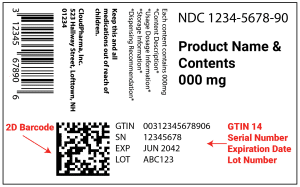
Helping You Achieve Serialized Traceability and Ensure FDA Compliance
Over the last several years, the US Food and Drug Administration (FDA) has developed new policies, the Drug Supply Chain Security Act (DSCSA) & the Unique Device Identifier (UDI). These policies are designed to provide end to end traceability and enhance the recall process of prescription drugs and medical devices distributed in the USA (AND to ultimately ensure the safety of US citizens!). Both regulations directly impact many stakeholders within the pharmaceutical supply chain, from contract manufacturers to logistics companies and even dispensaries (pharmacies).
Although there are many differences between the DSCSA and UDI standards, they both rely heavily on the serialization of each product included under their respective umbrella, using electronic data systems (including ERP & WMS). It is accepted (and most commonly recommended) to follow the Global Standards One (GS1) Guideline, as it is one of the most important global standard organizations and FDA-Accredited agency for UDI. This can be achieved by implementing a barcode scanner environment, with two-dimensional (2D) data matrix bar codes.
2D barcodes are preferred because they can hold much more information and can be read when printed in a smaller size than the typical UPC/DataBar. Below is a brief summary of the information that should be embedded in the barcodes affixed to each product:
Pharmaceutical Supply Chain – DSCSA Product Identifier:
- The Standardized Numerical Identifier (SNI): A set of numbers composed of the National Drug Code that correspond to the product and its packaged configuration (can be achieved using GS1’s Global Trade Item Number (GTIN) – more details at the end of this article), coupled with a unique alphanumeric serial number (up to 20 characters)
- The lot numbers
- The product’s expiration date
Medical Device Manufacturers and Labelers – Unique Device Identifier:

- The product code or device identifier: The first part of the UDI which identifies the labeler and the specific version and model of a device (Which can also typically be achieved by using GTIN)
- The production identifier: This data segment includes the following information regarding the manufacturing process:
- The device’s serial number
- The device’s lot number
- The device’s expiration date
- The device’s date of manufacture
Moving Forward: FDA-Compliant ERP & WMS Software
Manufacturers, wholesale distributors, and other third parties involved in the medical device and pharmaceutical industries must ensure that the necessary procedures and controls are in place to comply with the regulations. Deploying the right technology is often the key to achieve compliance. Here is how LISA WMS will
help fulfill ERP/supply chain requirements:
- Serial number tracking, seamlessly integrated to SAP Business One
- Lot number tracking
- Expiration date tracking
- Bar code scanning, including GS1 labels
- Repacking and label printing (including bar codes)
- Electronic Data Interchange (EDI) integration
- Incoming/outgoing Return Merchandise Authorization (RMA) support
By aligning LISA WMS to meet the upcoming FDA requirements, the N’ware team demonstrates its commitment to providing the best Supply Chain Management add-ons to its valued SAP Business One clients and partners.
Could FDA-compliance be an opportunity to improve supply chain efficiency?
Definitely, YES! As warehouse management specialists, we know that bar code scanning is typically a major improvement factor in a warehouse environment. According to KPMG’s 2017 Serialization & Traceability Trends, more than 70% of the organizations impacted by the regulations had or were planning to use serialization as an opportunity to streamline business processes
How can we help?
The LISA WMS expert team can help you navigate your way forward in the pharmaceutical and medical device industries, not only to proactively achieve compliance, but also to help you leverage digital transformation to drive innovation and enterprise value.
Additional information:
Global Standards One (GS1): GS1 is a not-for-profit information standards organization that facilitates industry collaboration to help improve supply chain visibility and efficiency through the use of GS1 Standards, the most widely used supply chain standards system in the world. A few examples of these applications are: unique numbering and identification systems, barcodes, Electronic Product Code-based RFID, data synchronization, and electronic information exchange.
Global Trade Item Number (GTIN): GTIN is a family of standard data structures using 8, 12, 13 or 14 digits to identify trade items as defined by the GS1 General Specifications. The GTIN14 can be particularly useful to create a “packaging hierarchy” in order to easily track the details of packed and repacked items across the supply chain. It is currently used only within barcode labels.
For more details regarding each regulation, please refer to the US FDA’s website: www.fda.gov
KPMG’s 2017 Serialization & Traceability Trends
To learn more about our supply chain applications and traceability for the medical devices industry here.
Please note that the comparisons provided here are not intended to provide legal advice. To determine how your business may be affected by UDI and DSCSA, please consult with your legal counsel.




